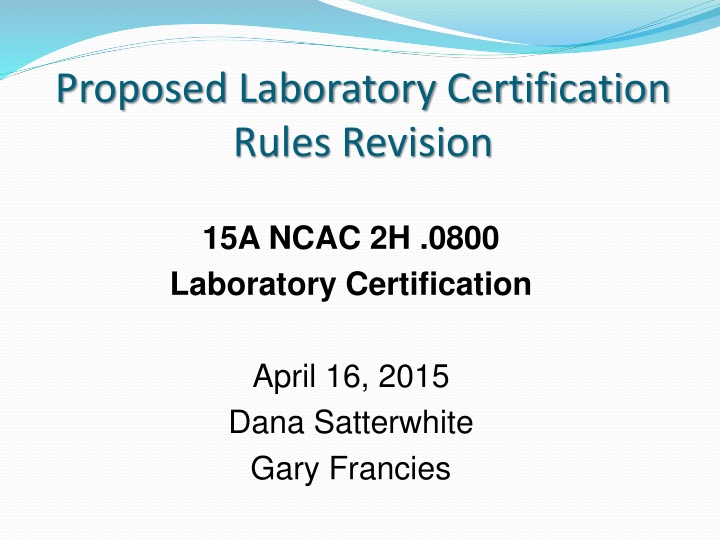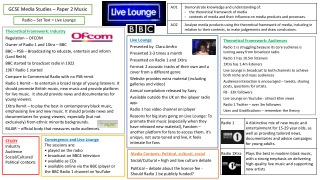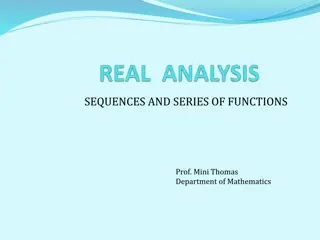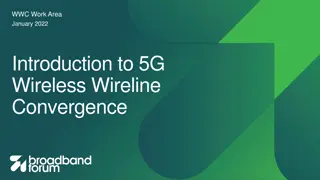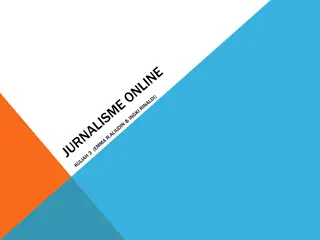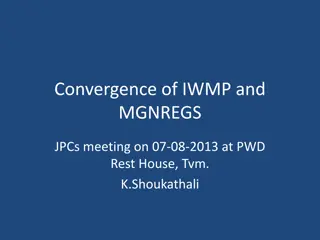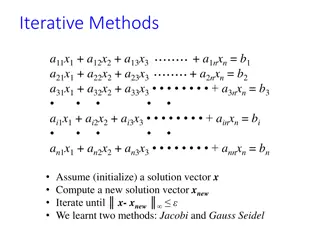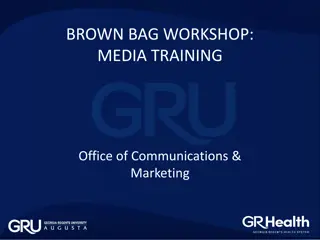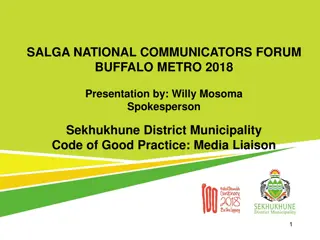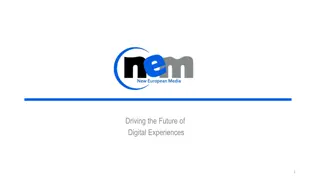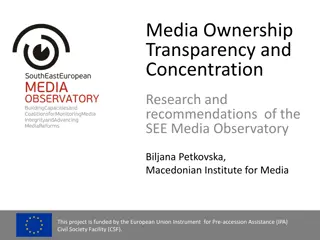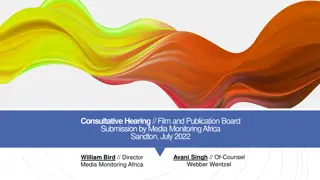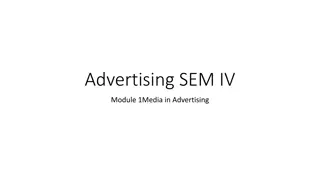Understanding Media Sectors & Technological Convergence
In the world of media, there are five distinct sectors involved in creating various products. These sectors, known as the 5 MEDIA SECTORS, encompass industries like Netflix, Spotify, and Candy Crush. The convergence of technology has revolutionized how people consume media, as seen in the example of smartphones replacing separate devices like cameras and music players. Technological convergence refers to the integration of various technologies into a single multifunctional device or service, streamlining convenience and enhancing user experience. Explore more examples of devices that showcase this convergence and delve into the impact on modern consumer behavior.
Download Presentation

Please find below an Image/Link to download the presentation.
The content on the website is provided AS IS for your information and personal use only. It may not be sold, licensed, or shared on other websites without obtaining consent from the author.If you encounter any issues during the download, it is possible that the publisher has removed the file from their server.
You are allowed to download the files provided on this website for personal or commercial use, subject to the condition that they are used lawfully. All files are the property of their respective owners.
The content on the website is provided AS IS for your information and personal use only. It may not be sold, licensed, or shared on other websites without obtaining consent from the author.
E N D
Presentation Transcript
Proposed Laboratory Certification Rules Revision 15A NCAC 2H .0800 Laboratory Certification April 16, 2015 Dana Satterwhite Gary Francies
Overview The North Carolina Wastewater/Groundwater Laboratory Certification (NC WW/GW LC) program is a vital component in the effort to ensure the quality of analytical data used to make informed regulatory decisions by various programs within the Department of Environment and Natural Resources (DENR).
Applicability The Laboratory Certification Rules apply to: Commercial, Industrial, Municipal, Field Other laboratory monitoring analyses that will be used to report compliance data to the State of North Carolina. and facilities which perform Our program currently certifies >700 laboratories across the United States.
Programs supported Groundwater Wastewater Solid and Hazardous Waste Surface Water Waste Not Discharged to Surface Waters Point Source Discharges to the Surface Waters All wastewater treatment plant laboratories having Local Pretreatment Programs. Underground Storage Tank program
Revisions We are proposing various amendments, repeals and adoptions that would result in: Previous stakeholder comment inclusion Appending the list of certifiable parameters Clarifying existing legislative rules or providing additional quality control requirements where a Rule does not exist Codifying current policies and providing consistency among regulatory programs Improving the data quality standards for Field Labs (the rules have not been updated since 2002)
Current Fees No fee increases are proposed
Additional Certifiable Parameters Non-Field labs Inorganic parameters Acidity Bromide CBOD DOC Enterococci E. coli Ignitability/Flashpoint Paint Filter Liquids Volatile Residue Silica Metals Boron Total Hardness Lithium Potassium Phosphorous Sodium Strontium Titanium SPLP TCLP Organics Explosives Organic Halides SPLP TCLP
Additional Certifiable Parameters Field labs Free Available Chlorine Turbidity* Salinity Sulfite Vector Attraction Reduction Options 5, 6 & 12
Minor Technical Changes Simplify the Scope Update Division, Section names, etc. Update to current terminology used in our field (e.g., Class S vs. ASTM 1 and 2 weights, PE vs. PT, etc.)
Codifies PT Requirements EPA DMR-QA PT Exemption compliance PTs must be analyzed in the same manner as routine environmental samples [.0805 (a) (2)] Graded PT reports must be sent to the Certification Branch directly from the vendor [.0805 (a) (2) (A)]
Codifies PT Requirements Laboratories must submit a documented root cause analysis and corrective action report for PT failures [.0805 (a) (2) (A)] Laboratories are prohibited from sharing PT results prior to a PT study deadline [.0807 (a) (16)] NOTE: Up to 4 PTs per year is not new. Routine is 1 PT per year. Additional PTs may be requested for troubleshooting purposes.
Additional Quality Control Legal defensibility plays a more prominent role now than it did in 2002. Requires review of QAM/SOPs every 2 years and track changes [.0805 (a) (7)] Laboratories must establish acceptance criteria for QC elements where none is prescribed [.0805 (a) (7) (A)] Requires that analytical data must be accurate (e.g., mg/L vs. ug/L) [.0805 (a) (7) (B)]
Additional Quality Control* Codifies that laboratories must take documented corrective action for QC failures [.0805 (a) (7) (E)] Codifies additional documentation requirements for benchsheets and support equipment logs [.0805 (a) (7) (G)] Allows calibration standards equal to or less than the lab s lowest reporting concentration [.0805 (a) (7) (H)]
Additional Quality Control Codifies requirements for CV/2nd source/PQL check/CCV and CCB after every 10 samples [.0805 (a) (7) (H)] Codifies blank acceptance criterion [.0805 (a) (7) (H) (i)] Codifies verification requirements for factory-set curves [.0805 (a) (7) (H) (iv)]
Additional Quality Control Codifies traceability requirements for chemicals, reagents and standards [.0805 (a) (7) (K)] Codifies additional documentation requirements for sample preservation verification and non-compliance notifications [.0805 (a) (7) (M)] Adds the requirement for a documented training program [.0805 (a) (7) (O)]
Revisions Specific to Field Labs Clarifies which rules pertain to Field Labs Adds QC and documentation requirements consistent with Non-field Lab requirements to provide consistency and improve data quality
Improving the Data Quality Standards for Field Labs Expanded record retention requirements [.0805 (g) (1)] Expanded certified data documentation requirements [.0805 (g) (2)] Added the requirement for SOPs [.0805 (g) (4)] Added the requirement for a documented training program [.0805 (g) (5)]
Improving the Data Quality Standards for Field Labs Codified requirements for traceability management and documentation for chemicals, standards and reagents [.0805 (g) (7)] Added requirements for inspections and record submission [.0805 (g) (9)] Codified PT requirements [.0805 (g) (13)] Added requirements for written notification of changes [.0805 (g) (15)]
Miscellaneous Changes Allows supervisor to contact rather than visit the lab daily [.0805 (a) (3) (C)] Extends substitute supervisor time to match FMLA policy [.0805 (a) (3) (C)] Prohibits altering a certificate or misrepresenting the scope of accreditation [.0807 (a) (15)] Requires additional subcontracting information when a lab is decertified [.0807 (e) (3)]
Revisions with financial impact Increased residue standard frequency [.0805 (a) (7) (C)] Requirement to review QA/QC/SOPs every 2 years [.0805 (a) (7)] Increased frequency for multiple weight checks for balance [.0805 (a) (7) (J)] Requirement that Field Labs must have SOPs [.0805 (g) (4)]
Reducing Financial Burden Exception to definition of Commercial Lab [.0803 (5)] Providing URLs where reference documents are free [.0805 (a) (1)] Allowing PTs analyzed in the last 6 months for initial cert [.0805 (a) (2) (B)] Establishing the term Parameter Method Technology [.0803]
Reducing Financial Burden Repealing submission of the application in duplicate [.0805 (a) (5)] Allowing the use of 3rd party assessors [.0805 (a) (5)] Repealing requirements [.0805 (a) (6)] minimum bench space, sink, balance Expanding the allowable supervisor credentials for Field Labs (change to or equiv. combination of education and work exp. And change to Physical/Chemical Operator Certification)[.0805 (g) (8)]
Reducing Financial Burden Allowing the use of Approved Procedures for field analyses [0805 (g) (4)] Repealing submission of application for change notification [.0805 (c) (8)] Changing pro-rating schedule to quarterly [.0806 (d)]
Reducing Financial Burden Reducing the minimum decertification period to 30 days [.0807 (e) (3)] Allowing the use of printable benchsheets [.0805 (a) (7) (G)] and [.0805 (g) (1)] Adding Turbidity to the Field Parameter definition [.0803 (10)]
Stakeholder Outreach Rules have been sent out electronically. Hard copies mailed to all labs without email. Proposed Rules are posted on our web site. Conducted stakeholder meetings. Will be sending a fiscal analysis survey.
Stakeholder Meetings We have 3 stakeholders meetings scheduled. Burlington April 1, 2015 April 9, 2015 Wilson Asheville April 16, 2015 Would like comments by April 30, 2015.
Anticipated Timeline Subject to change Comments on proposed revision to us by April 30, 2015 Incorporating comments completed by June 30, 2015 Draft rules posted to EMC website by October, 2015 EMC Committee review in November, 2015 EMC in January, 2016 Public Hearings in March, 2016 EMC for approval in September, 2016 Implementation sometime in 2017
Submit Comments Dana Satterwhite Dana.satterwhite@ncdenr.gov Gary Francies Gary.francies@ncdenr.gov Mail to: Dana Satterwhite Water Sciences Section NC Wastewater/Groundwater Laboratory Certification Branch 1623 Mail Service Center Raleigh, North Carolina 27699-1623
Website http://portal.ncdenr.org/web/wq/lab/cert/rulesrevision Proposed DRAFT Rule Revision Instructions for submitting comments Stakeholder meeting information Comments received by affiliation type Changes made based upon stakeholder comment
Questions Any Questions or Comments? Any Unintended Consequences? Financial Impact?
